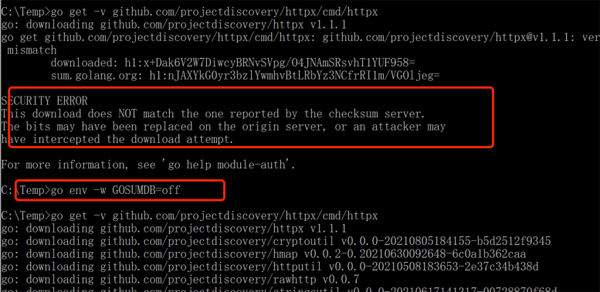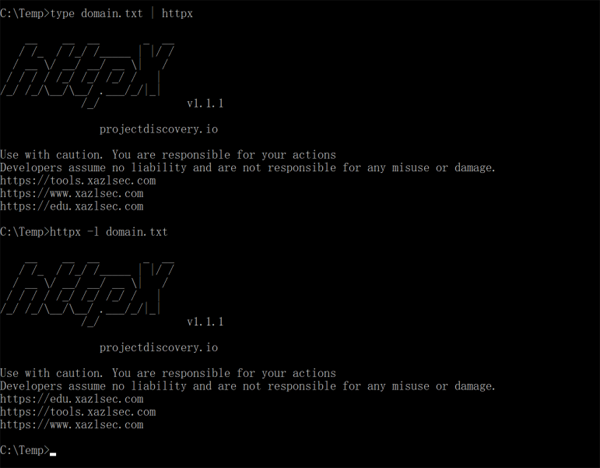命令行版 HTTP 工具集,自動化檢查網站狀態
如果我們有幾十萬個網站需要檢測,該如何實現?手工檢測嗎?當然不行,這是非常不現實的,只有自動化才是正確的選擇,那么如何自動化實現?
對于幾十個網站的目標,如果要對所有網站進行掃描,每一個網站的掃描都需要比較長的時間,而且,其中難免有很多無效網站,如果我們可以將無效網站排除,那么我們就可以節省掃描的時間,從而提升檢測效率。
自動化檢測,離不開自動化的工具,今天來為大家分享一款命令行版的 HTTP 工具集 httpx,項目地址:
https://github.com/projectdiscovery/httpx
該工具使用 go 語言編寫,安裝方式也比較簡單,需要提前安裝 go 環境,安裝完成之后需要換成國內的代理,否則安裝的時候,會出現連接超時的問題,安裝命令如下:
- go get -v github.com/projectdiscovery/httpx/cmd/httpx
Windows 下安裝時報錯,然后執行下面的命令之后,再進行安裝就可以了:
- go env -w GOSUMDB=off
安裝完成之后,查看幫助信息:
- [root@vultrguest ~]# httpx -h
- Usage of httpx:
- -H value # 自定義 header,比如 UA、cookie 等
- Custom Header
- -allow value
- Allowlist ip/cidr
- -body string
- Content to send in body with HTTP request
- -cdn # 根據頁面返回 header,判斷是否存在 cdn
- Check if domain's ip belongs to known CDN (akamai, cloudflare, ..)
- -cname
- Output first cname
- -content-length # 輸出返回包的長度
- Extracts content length
- -content-type # 輸出網站的內容類型
- Extracts content-type
- -csp-probe
- Send HTTP probes on the extracted CSP domains
- -debug
- Debug mode
- -deny value
- Denylist ip/cidr
- -exclude-cdn
- Skip full port scans for CDNs (only checks for 80,443)
- -extract-regex string
- Extract Regex
- -fc string # 過濾掉某些狀態碼的網站,比如 404、500 等
- Filter status code
- -filter-regex string
- Filter Regex
- -filter-string string
- Filter String
- -fl string
- Filter content length
- -follow-host-redirects
- Only follow redirects on the same host
- -follow-redirects
- Follow Redirects
- -http-proxy string # 設置請求代理
- HTTP Proxy, eg http://127.0.0.1:8080
- -http2
- HTTP2 probe
- -include-chain
- Show Raw HTTP Chain In Output (-json only)
- -include-response
- Show Raw HTTP Response In Output (-json only)
- -ip # 輸出域名對應的 IP
- Output target ip
- -json
- JSON Output
- -l string
- File containing domains
- -location
- Extracts location header
- -match-regex string
- Match Regex
- -match-string string
- Match string
- -mc string
- Match status code
- -method
- Display request method
- -ml string
- Match content length
- -no-color
- No Color
- -no-fallback
- If HTTPS on port 443 is successful on default configuration, probes also port 80 for HTTP
- -no-fallback-scheme
- The tool will respect and attempt the scheme specified in the url (if HTTPS is specified no HTTP is attempted)
- -o string
- File to write output to (optional)
- -path string
- Request path/file (example '/api')
- -paths string
- Command separated paths or file containing one path per line (example '/api/v1,/apiv2')
- -pipeline
- HTTP1.1 Pipeline
- -ports value
- ports range (nmap syntax: eg 1,2-10,11)
- -probe
- Display probe status
- -random-agent
- Use randomly selected HTTP User-Agent header value (default true)
- -rate-limit int
- Maximum requests to send per second (default 150)
- -request string
- File containing raw request
- -response-in-json
- Show Raw HTTP Response In Output (-json only) (deprecated)
- -response-size-to-read int
- Max response size to read in bytes (default - unlimited) (default 2147483647)
- -response-size-to-save int
- Max response size to save in bytes (default - unlimited) (default 2147483647)
- -response-time
- Output the response time
- -resume
- Resume scan using resume.cfg
- -retries int
- Number of retries
- -silent
- Silent mode
- -sr
- Save response to file (default 'output')
- -srd string
- Save response directory (default "output")
- -stats
- Enable statistic on keypress (terminal may become unresponsive till the end)
- -status-code
- Extracts status code
- -store-chain
- Save chain to file (default 'output')
- -tech-detect
- Perform wappalyzer based technology detection
- -threads int
- Number of threads (default 50)
- -timeout int
- Timeout in seconds (default 5)
- -title
- Extracts title
- -tls-grab
- Perform TLS data grabbing
- -tls-probe
- Send HTTP probes on the extracted TLS domains
- -unsafe
- Send raw requests skipping golang normalization
- -verbose
- Verbose Mode
- -version
- Show version of httpx
- -vhost
- Check for VHOSTs
- -vhost-input
- Get a list of vhosts as input
- -web-server
- Extracts server header
- -websocket
- Prints out if the server exposes a websocket
- -x string
- Request Methods, use ALL to check all verbs ()
使用場景一:檢查網站是否存活
將網站列表保存為一個文本,比如:
最簡單的命令,無需加任何參數:
- type domain.txt | httpx (windows)/ cat domain.txt | httpx (Linux)
或者
- httpx -l domain.txt
無法訪問的網站,在結果中未進行顯示:
這個工具在 linux 下使用顯示會比較好看,如果我們想要顯示連接失敗的網站,可以使用命令:
- httpx -l domain.txt -silent -probe
使用場景二:獲取網站 Title 、狀態碼等
通過獲取網站的 Title 和狀態碼,可以排除大量非正常網站,比如 404、500 等狀態碼,還有很多域名指向同一個網站,然后通過網站標題可以去掉大量重復的網站域名,從而提升檢測的效率。
- httpx -l domain.txt -title -tech-detect -status-code
對于有大量無法訪問網站的情況,默認的超時時間是 5 秒,想要提升速度,可以將超時時間,比如:
- httpx -l domain.txt -title -tech-detect -status-code -timeout 2
目標多的情況下,可以結合多線程技術,使用參數 -threads:
- httpx -l domain.txt -title -tech-detect -status-code -timeout 2 -threads 30
如果還想獲取目標網的服務器信息,可以使用 -web-server 參數:
- httpx -l domain2.txt -title -tech-detect -status-code -threads 30 -web-server
使用場景三:使用域名作為目標,獲取網站信息
當我們收集了很多域名,并沒有生成網站的鏈接,httpx 通用可以檢測域名上搭建的網站信息,比如下面的域名:
通用使用獲取 title 的命令:
- httpx -l domain2.txt -title -tech-detect -status-code -timeout 2 -threads 30
總結
本文對 httpx 做了一個簡單的使用,工具好壞主要與使用者面臨的問題和需求決定,當你需要時,它是一個提效的好幫手,當你不需要時,他不過就是個工具而已,對于大量目標的狀態檢測和信息收集,httpx 是個不錯的幫手,在這幾天的實戰訓練營中,這個工具也是可以使用的,當然,如果自己有編碼基礎,寫腳本來實現自己的目標,更高效且高度自定義化,滿足自己的各種需求,公開的工具多少是有缺陷的,作者不可能把所有狀況都考慮到,而且在使用的時候,目標過多的情況下,會出現各種各樣的 bug,參與訓練營的小伙伴,多少都體驗多了。










































